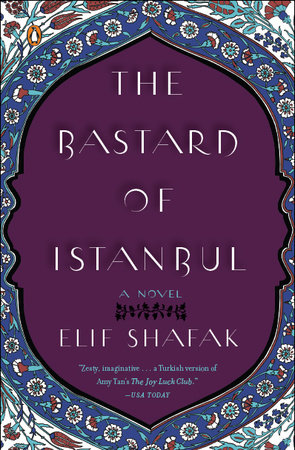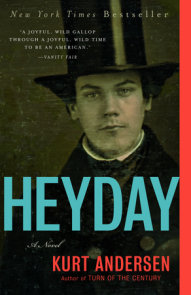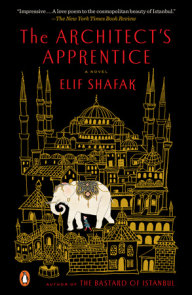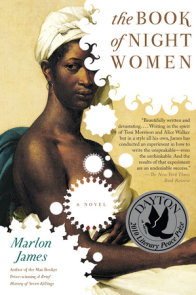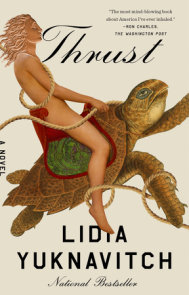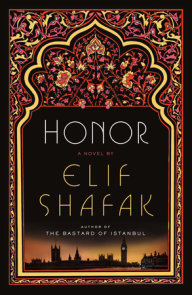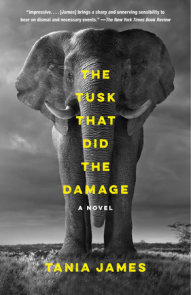READERS GUIDE
Questions and Topics for Discussion
INTRODUCTION
Nineteen-year-old Asya, like many teenagers, is full of rage. Feeling like an outsider in a family of suffocating women, she rebels against everything she thinks her family and culture expect from her. Born and raised in Istanbul, Turkey, Asya is the youngest female of the Kazanci family: There’s Petite-Ma, the delicate great-grandmother slowly losing her memories to Alzheimer’s; Grandma Gülsüm, a harsh woman who must bitterly corral an unruly bunch of daughters after her only son, Mustafa, flees to America; Auntie Banu, who chooses to live with her sisters rather than her own husband and channels her piety into a career as a soothsayer; Auntie Feride, who has spent her life careening from one mental illness to the next; Auntie Cevriye, a tightly wound, widowed high school history teacher; and Auntie Zeliha, the youngest, who runs a tattoo parlor and refuses to play by anyone’s rules. Zeliha also happens to be Asya’s mother.
Asya, an illegitimate child, is ignorant of her father’s identity and torn between wanting desperately to know the truth of her past and launching herself toward a future that is built independently of her unknown roots. Her conflicted feelings about the past take on more immediacy when her Uncle Mustafa’s stepdaughter, Armanoush, suddenly comes to visit. An Armenian American and a child of the Armenian diaspora who is struggling with the oppressive history of her ancestors, Armanoush hopes that by visiting the country where her family faced such sorrow and loss in the 1915 deportations and massacres, she can finally pin down her own identity. In Istanbul—a city stuck between East and West, past and future, simultaneously an inviting amalgam of stone, color, and sound and an impenetrable, deceptive façade—the two girls set in motion a series of events that uncover long-buried secrets that will link the two girls and their families together in ways no one could expect.
Shafak has created an intricately woven tale about the very different but equally difficult struggles of living with the past and trying to survive without one. Full of bold, unforgettable characters, The Bastard of Istanbul reveals that even the worst events are important ingredients in the recipes that make each of us who we are.
ABOUT ELIF SHAFAK
Elif Shafak is one of Turkey’s most acclaimed and outspoken novelists. She was born in 1971 and is the author of six novels, most recently The Saint of Incipient Insanities, The Gaze and The Flea Palace, and one work of non-fiction. She teaches at the University of Arizona and divides her time between the US and Istanbul.
A CONVERSATION WITH ELIF SHAFAK
Q. Where were you born, and when and how did you come to live in America?
A. I was born in France, Strasbourg, in 1971. All throughout my childhood and youth I have lived in different cities and countries, including Madrid, Spain; Amman, Jordan; and Cologne, Germany. Then in my thirties I came to the United States, first to Boston, then Michigan and Arizona. I am not an immigrant. I guess all my life I have been a nomad, a commuter.
Q. You divide your time between Istanbul, Turkey, and Tucson, Arizona. What do you think is the most striking contrast between the two cities? What do you think they have most in common?
A. Right now I divide my time between these two cities and the contrast couldn’t be deeper. Tucson when compared to Istanbul is quiet, sterile, and ordered. But it is the desert that fascinated me as I learned to live with her around. The desert and Tucson are calm whereas Istanbul is anything but. She is a restless city of more than 10 million. When the pace of the latter is tiring I feel a need to escape to the former. But when the peace and quiet of the former suffocates, I feel a need to come back to Istanbul. I guess I need both.
Q. Your novel gives readers insight into both the Turkish and Armenian cultures and some of their respective problems. What personal experiences led you to portray these two peoples in the way that you have?
A. I am the child of a Turkish diplomat. I was raised by a single mother, and she became a diplomat around the time I was ten or eleven. And when we were in Madrid, Spain, Armenian terrorists were killing Turkish diplomats. My first acquaintance with Armenian identity is very negative. There is no way terrorism can be legitimized or approved. But that said, in time as I kept reading, thinking, and collecting stories of real people, as a writer and intellectual my pursuits brought me to a point where I had to face the tragic events of 1915 and rethink the whole past.
Q. The Kazanci and Tchakhmakhchian families really come to life in this novel. Which of these characters, and their relationships with each other, were inspired by your own family?
A. I grew up without seeing my father and all my life he has been absent. In that sense there are similarities. The title that I wanted to give the novel at the beginning was “Baba and the Bastard”—baba meaning father in Turkish. I wanted to deal with the absence of the father. Also, as a child I was surrounded by women: grandmother, aunts, neighbors . . . ordinary and sometimes ignorant but definitely strong willed and beautiful souls they were. All of those have been reflected in the book. And the Tchakhmakhchian family has been inspired by my Armenian friends in America and Turkey. While I was writing this novel I had a chance to talk to many Armenian women. They opened the doors of their homes to me and I am grateful to them for sharing their stories with me.
Q. Though American pop culture references are sprinkled throughout the novel, you chose Johnny Cash as Asya’s sole musical interest. Why?
A. First of all because I love Johnny Cash myself. Music has always been a very central ingredient in my fiction, not only in terms of pop culture or alternative music genres (which I am very interested in), but also in the sense that when I write fiction it is to me a matter of rhythm, of music. And in all my novels music plays an important role. I think every story brings its own music along, and then, when the reader starts to read the book, she too hears it.
Q. 6. Your female characters appear in many different lights in the novel: as Muslims, members of a secular state, foreign exiles, social outcasts, Americans brought into foreign families, sisters, daughters, wives, lovers, and friends. What statement do you feel The Bastard of Istanbul makes about women’s roles both past and present?
A. This is a book in which women play the central role, both Armenian and Turkish women.
I believe women’s relation to the past is quite different than men’s. My country is a country of collective amnesia. Yet, if we still have some memory of the past, we owe it to women. Women pass their heritage from one generation to another, through recipes, songs, lullabies, and stories. These are all ordinary but precious gems of daily life. While I was writing this novel I did not deal with big macro-political questions. Just the opposite: I probed the simple and basic ingredients in the everyday life of Armenian and Turkish women. And they have so much in common.
Q. You write in both Turkish and English. What prompted you to write The Bastard of Istanbul in English? How does the process differ for you when writing in each language? Do you find that you are writing for different audiences or just using different vocabularies?
A. Every language has its own labyrinth, its own rhythm. As a writer it fascinates me to discover that. It is a big challenge, not only a linguistic challenge, but also an existential one. In another language you have to rediscover your literary voice, start from scratch again. But despite the difficulties involved I enjoy commuting between languages because I am fascinated with language in the most abstract sense. Just like a Jewish mystic or a Hurufi, an Islamic mystic in love with letters, I do not see language as an instrument and myself outside or above it. Rather, I see language as a new continent and want to explore its meadows, precipices, mountains, and landscape. A new language gives you a new zone of existence. You become a different person as you switch from one language to another.
I know many Turkish women who were raised bilingual cannot possibly utter any bad words in Turkish, because it is not proper for women to use that kind of language in this culture. But when I hear them speak English, I notice they do swear freely, without reservations, as if it is OK to swear in English but not in Turkish. I observe these linguistic journeys.
Q. How have the Turkish and American literary worlds each received your work? What aspects of being a Turkish author and an American author do you most enjoy? Which aspects do you find most difficult?
A. There are differences. I am a well-known writer in Turkey. I was somebody in Turkey when I came to the United States four years ago. Then in a day I became a nobody. If you are a painter you can take your paintings with you when you move from one country to another. You can take your music with you if you are a musician, or your documentaries if you are a documentary maker. But when you are a novelist and you have almost nothing translated into English yet (at that point I didn’t), you literally become a nobody in a day. And I liked that. I was so famous in Turkey, a country in which the novelists are always in the public eye, it both frightened and fascinated me to become nobody and start from there again, this time writing in English.
The two countries are so different. In Turkey the literary world is deeply politicized. A novelist is a public figure. It is a writer-oriented framework. We concentrate on the persona of the writer but not so much on her writing. In the United States it is more writing oriented and I like that.
Q. Your love for Istanbul shines through the pages of this novel. You do not spend as much time depicting your other home, Tucson. What other American cities have you spent time in? Do any of them come to life for you the way Istanbul does?
A. While giving readings and talks at different universities or bookstores, I had the chance to travel to many places in the United States. I lived a year in Boston, then in Ann Arbor, Michigan, and then moved down south after an offer from the University of Arizona. I love traveling in the United States and seeing the different layers in this country, both in terms of landscape and people. I am fascinated with New York, and in many ways I do see similarities between New York and Istanbul. I think New York is closer to Istanbul than to Arizona or the Midwest.
Q. Your character Baron Baghdassarian delivers an indictment: “Just like the Turks have been in the habit of denying their wrongdoing, the Armenians have been in the habit of savoring the cocoon of victimhood” (p. 263). What fresh perspectives on the past and present do you hope Armenian and Turkish readers will find among the pages of this novel? What would you most like American readers to understand about these communities?
A. I think we Turks need to overcome our amnesia and build a sense of continuity in time. Being so future oriented has made us very dynamic, and yet at the same time we could not mature because you cannot mature, either as a society or individual, without coming to grips with your past. That said, I think Armenians in the diaspora can be too past oriented and memory driven. When I meet a young Armenian, like eighteen or nineteen years old, I meet someone with a very old memory, the memory of her grandmother. But being too past-oriented can blur someone’s vision. Eventually, I wish we Turks could remember, and Armenians could forget.
Q. What books and writers have been particularly influential in your life?
A. So many . . . I have always had a very eclectic reading list. Russian literature, particularly Dostoyevsky, gloomy voices in European literature, such as Michel Tournier, Henry Mulisch, and of course Virginia Woolf. And then multiple voices in American literature, such as Joyce Carol Oates, Paul Auster, Toni Morrison . . . To this endless list I must add my interest in Sufism. I also read extensively on Jewish and Islamic mysticism. As a political scientist, books on political philosophy too are an inspiration for me, particularly Spinoza and Deleuze.
Q. What are you working on now?
A. Right now I am working on my baby, as I just had a daughter. At the same time I am working on a script on honor killings. I want to use the most popular agency, that is to say, the TV, to question and confront sexism and honor killings.
DISCUSSION QUESTIONS







